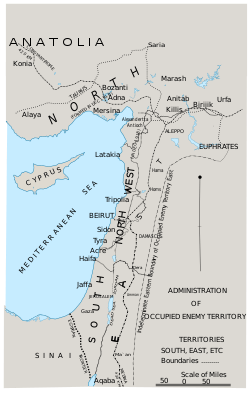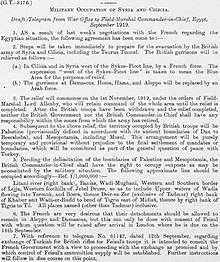Occupied Enemy Territory Administration
The Occupied Enemy Territory Administration (OETA) was a joint British, French and Arab military administration over Levantine provinces of the former Ottoman Empire between 1918 and 1920, set up on 23 October 1918 following the Sinai and Palestine Campaign and Arab Revolt of World War I.[1] Although it was declared by the British military, who were in control of the region, it was preceded on 30 September 1918 by the 1918 Anglo–French Modus Vivendi in which it was agreed that the British would give the French control in certain areas, and the Hashemites were given joint control of the Eastern area per T.E. Lawrence's November 1918 "Sharifian plan".[2]
Occupied Enemy Territory Administration | |||||||||||||||||||||||||||
|---|---|---|---|---|---|---|---|---|---|---|---|---|---|---|---|---|---|---|---|---|---|---|---|---|---|---|---|
| 1918–1920 | |||||||||||||||||||||||||||
.svg.png) Flag | |||||||||||||||||||||||||||
 Area of the OETA, according to the British Government's History of the Great War Based on Official Documents[1] | |||||||||||||||||||||||||||
| Status | Occupied territory | ||||||||||||||||||||||||||
| Common languages | Arabic, Ottoman Turkish, French, English | ||||||||||||||||||||||||||
| Administrators | |||||||||||||||||||||||||||
| History | |||||||||||||||||||||||||||
• Established | 1918 | ||||||||||||||||||||||||||
• San Remo conference | 19 to 26 April 1920 | ||||||||||||||||||||||||||
• Disestablished | 1920 | ||||||||||||||||||||||||||
| |||||||||||||||||||||||||||
Following the occupation of the Adana Vilayet (the region of Cilicia) in December 1918, a new territory, OETA North, was set up.[3]
The administration ended in OETA West and OETA South in 1920 following the assignment of the French Mandate of Syria and Lebanon and British Mandate for Palestine at the 19–26 April 1920 San Remo conference.[4]
In OETA East, British administration ended following the withdrawal of British forces from the territory in November 1919, and the subsequent declaration of the Arab Kingdom of Syria over the same area. The area was split into two after the French defeated King Faisal in July 1920; the northern part of the territory was combined with the French-administered OETA West, and the southern part became a no man's land and later became the Emirate of Transjordan.[5]
History
Initiation
| OETA South | OETA West | OETA East | Totals | |
| Muslims | 515,000 | 600,000 | 1,250,000 | 2,365,000 |
| Christians | 62,500 | 400,000 | 125,000 | 587,500 |
| Druses | 60,000 | 80,000 | 140,000 | |
| Jews | 65,000 | 15,000 | 30,000 | 110,000 |
| Others | 5,000 | 20,000 | 20,000 | 45,000 |
| Totals | 647,500 | 1,095,000 | 1,505,000 | |
| Grand Total | 3,247,500 |
On 23 October 1918, following the British and Arab forces' defeat of the Ottoman empire, Field Marshal Edmund Allenby announced that the region was to be split into three administrative sub-units, which varied very little from the previous Ottoman divisions:[6][7]
- OETA South, consisting of the Ottoman Mutasarrifate of Jerusalem and the sanjaks of Nablus and Acre. This was the first administrative definition of what was to become Mandatory Palestine;[8]
- OETA West (originally OETA North, renamed two months later) consisting of the Ottoman sanjaks of Beirut, Lebanon, and Latakia, and a number of sub-districts; and
- OETA East consisting of the Ottoman Damascus Vilayet and the southern part of the Aleppo Vilayet. The governors of Aleppo were later to sponsor the Occupation of Zor. The area of Ma'an and Aqaba was administered by OETA East and claimed by the Hejaz.
In December 1918, following the occupation of the region of Cilicia, a new territory was set up.[3]
- OETA North, consisting of the Adana Vilayet
Later events

Under this administration the immediate needs of the people were provided for, seed grain and live-stock were imported and distributed, finance on easy terms was made available through the Army bankers, a stable currency was set up and postal services restored.[10] Allenby insisted that as long as military administration was required, it was to remain his responsibility.[11]
But, success of Turkish War of Independence, Maraş, Antep and Urfa sanjaks of former Halep Eyalet remained in Turkey after 1921. Also, Antakya and İskenderun kazas of Halep Sanjak in one were separated as the Republic of Hatay in 1938. The republic joined to Turkey in 1939.
Military administrators
OETA South Chief Administrators
- Major General Arthur Wigram Money (June 1918 – June 1919)
- Major General Harry Davis Watson (June 1919 – December 1919)
- Lieutenant-General Louis Bols (January 1920 – July 1920)
The area was divided into four districts: Jerusalem, Jaffa, Majdal and Beersheba, each under a military governor.
Both of the first two British administrators, Generals Money and Watson, were removed by London for not favoring the Zionists over the Arabs;[12] when the OETA administration ended, Zionist politician Herbert Samuel was installed as the first civilian administrator.[12] Samuel recorded his acceptance of the role, and the end of military administration, in an often-quoted document: "Received from Major-General Sir Louis J. Bols K.C.B.—One Palestine, complete."[13]
OETA East Administrators
OETA East was a joint Arab-British military administration. The Arab and British armies entered Damascus on 1 October 1918, and on 3 October 1918 Ali Rida al-Rikabi was appointed Military Governor of OETA East.[14][15] Prince Faisal son of King Hussain of Mecca entered Damascus as on 4 October and appointed Rikabi Chief of the Council of Directors (i.e. prime minister) of Syria.
The boundary definition of OETA East left uncertainties to the south and east, leading to competing claims from the Kingdom of Hejaz and Occupied Iraq respectively – see Occupation of Ma'an and Occupation of Zor for further details.
- Rida al-Rikabi (3 October 1918 – 26 November 1919)[16]
OETA North (West) Administrators
- Marie Antoine Philpin de Piépape (7 Oct 1918 - 19 Nov 1918)
- Jules Camille Hamelin (19 Nov 1918 - 21 Nov 1919)
- François Georges Barb (21 Nov 1919 - 1 Sep 1920)
OETA North (Cilicia) Administrators
Initiation and administration
The OETA was established on 23 October 1918, under the accepted rules of military occupation, and defined as follows:
1. The enemy territory occupied by the allied troops of the Egyptian Expeditionary Force will be divided, for purposes of provisional military administration, into three areas, each in charge of a "Chief Administrator" directly responsible in all cases to the Commander-in-Chief.The three areas and their Chief Administrators are : -
- (a) "Occupied Enemy Territory (South)". - Chief Administrator, -~ General Sir A. W. Money, K.C.B., C.S.I., (British). Comprises the Sanjaks of Jerusalem, Nablus, and Acre.
- (b) "Occupied Enemy Territory (North)". - Chief Administrator, - Colonel M.A.F.J. de Piepape, (French). Comprises the Sanjaks of Beirut, Lebanon, Ladikiya and the town of Beirut; the Kazas of Hasbiya, Rashiya, Jisr es Shaghur, Bay of Antioch, Yeniji Kali, Im Beidan, and Alexandretta.
- (c) "Occupied Enemy Territory (East)". - Chief Administrator, - Ali Riza El Rikabi (Arab). Comprises all districts East of (a) and (b) above, up to the northern limits of the Kazas of Jebel Seman and El Bab.
2. The system of administration will be in accordance with the Laws and Usages of War as laid down in Ch. XIV, S.8, Manual of Military Law. Departures from these principles will not be permitted except with the approval of the Commander-in-Chief. As far as possible the Turkish system of government will be continued, and the existing machinery of government will be utilized.
3. The Administration will be required to provide for all necessary government services, and the extent to which these services can be developed, during the state of war, is left to the discretion of the Chief Administrator concerned.
4. As far as possible it is desired to retain Turkish administrative areas, and in this way to utilise existing Turkish records.
5. The Administration of the Ottoman Public Debt will be permitted to continue its functions, subject to the general control of the Chief Administrator.
6. The Régie Tobacco Monopoly will likewise continue its functions under similar conditions.
7. Chief Administrators will communicate with the Commander-in-Chief through the Deputy-Adjutant General, G.H.Q., to whom all reports will be addressed.
8. Chief Administrators will submit reports on the general situation in their areas, by 15th of each month.
9. In view of the fact that the administration is military, provisional, and without prejudice to future settlement, Chief Administrators will not underake, except in so far as is necessary for the maintenance of security and public order, any political propaganda, and will not take part in any political controversies.
— Public Record Office. W.O. 106. File 718; Secret (Telegram E.A. 1808 of 23.10.18)[17]
Disestablishment of OETA

The OETA administrations were disestablished at different times in each of the regions, following the formal appointment of civil administrations (prior to the formal coming into force of the mandates):
- OETA South: 1 July 1920, Herbert Samuel was appointed as High Commissioner for Palestine
- OETA North: 31 August 1920, Henri Gouraud proclaimed the State of Greater Lebanon, the Alawite State and the Sanjak of Alexandretta was merged into the State of Aleppo
- OETA East: 26 November 1919, when the British withdrew in favor of the Emirate of Syria.[16]
Bibliography
- Macmunn, G. F.; Falls, C. (1930). Military Operations: Egypt and Palestine, From June 1917 to the End of the War Part II. History of the Great War based on Official Documents by Direction of the Committee of Imperial Defence. II. accompanying Map Case (1st ed.). London: HMSO. OCLC 656066774.CS1 maint: ref=harv (link)
- Paris, Timothy J. (2003). Britain, the Hashemites, and Arab Rule, 1920-1925: The Sherifian Solution. Frank Cass. ISBN 978-0-7146-5451-5.CS1 maint: ref=harv (link)
- Biger, Gideon (2005), The Boundaries of Modern Palestine, 1840-1947. London: Routledge. ISBN 0-7146-5654-2.
References
- Macmunn & Falls 1930, p. 606-607.
- Paris 2003, p. 48.
- Macmunn & Falls 1930, p. 623.
- Macmunn & Falls 1930, p. 607-609.
- Macmunn & Falls 1930, p. 609: "The Arab zone was divided into two, the southern of which became, and remains to-day, the mandated territory of Trans-Jordan, under the rule of Abdulla, Hussein's second son. At Damascus the experiment was tried of a French-protected State under Feisal, but it speedily failed. Feisal was ejected by the French in July 1920, and Zone A linked with the Blue Zone under a common administration."
- Israel: the first hundred years, Efraim Karsh
- Roberto Mazza (30 September 2009). Jerusalem: From the Ottomans to the British. I.B.Tauris. pp. 148–. ISBN 978-0-85771-393-3.
- Biger, 2005, p.53: "This initial division along the lines of the Ottoman administrative division for the purposes of military government, was in fact the first definition of an area that would later be determined as 'Palestine'"
- Zogby, James (11 July 2008). "Opinions Matter: A Lesson From History". Huffington Post.
- Keogh, E. G.; Joan Graham (1955). Suez to Aleppo. Melbourne: Directorate of Military Training by Wilkie & Co. OCLC 220029983. p. 202–3
- Hughes, Matthew, ed. (2004). Allenby in Palestine: The Middle East Correspondence of Field Marshal Viscount Allenby June 1917 – October 1919. Army Records Society. 22. Phoenix Mill, Thrupp, Stroud, Gloucestershire: Sutton Publishing Ltd. ISBN 978-0-7509-3841-9. Allenby to Robertson 25 January 1918 in Hughes 2004, p. 128
- D. K. Fieldhouse (6 April 2006). Western Imperialism in the Middle East 1914-1958. OUP Oxford. pp. 198–. ISBN 978-0-19-153696-0.
- Owen, C. V. (2004). "Bols, Sir Louis Jean (1867–1930)". Oxford Dictionary of National Biography (online ed.). Oxford University Press. doi:10.1093/ref:odnb/31947. (Subscription or UK public library membership required.)
- William E. Watson (2003). Tricolor and Crescent: France and the Islamic World. Greenwood Publishing Group. pp. 53–. ISBN 978-0-275-97470-1.
- Eliezer Tauber (5 March 2014). The Arab Movements in World War I. Routledge. pp. 240–. ISBN 978-1-135-19978-4.
- Tauber, Eliezer (13 September 2013). The Formation of Modern Iraq and Syria. Routledge. pp. 30–. ISBN 978-1-135-20118-0.
- Alsberg, Paul Avraham (1973). "קביעת הגבול המזרחי של ארץ ישראל (Determining the Eastern Boundary of the Land of Israel)". In Daniel Carpi (ed.). הציונות: מאסף לתולדות התנועה הציונית והישוב היהודי בארץ־ישראל. אוניברסיטת תל-אביב, הוצאת הקיבוץ המאוחד.
available in pdf here